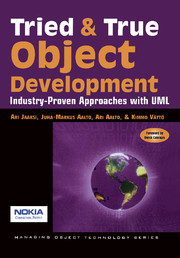Book contents
INTRODUCTION
Published online by Cambridge University Press: 06 July 2010
Summary
Software systems are becoming larger and more complex. Large groups of designers with different skill levels participate in the development of these systems. On one hand, the systems are becoming more critical and the requirements for their reliability and usefulness are growing. Thus, implementation of software systems is becoming more and more complicated and time-consuming. Because of this, major failures happen: software projects overshoot their schedules, systems do not function as required, or systems are not taken into use at all.
Because of the growing complexity and demanding requirements of software systems, software development cannot just depend on the exceptional but arbitrary achievements of talented designers. Instead, software development is becoming a more disciplined work, having both a scientific and an engineering basis. According to many researchers and practitioners, objectorientation together with the latest component-based paradigms is the most promising approach for systematic software development.
The Context of This Book
This book is about how to use objects and components in the development of large and complex software systems. It presents some new ideas but also introduces a synthesis of old ideas. These ideas and their combinations are currently in everyday use in various projects inside and outside Nokia. Thus, we have proof that the development of large software systems can be based on the presented approach. We have also experience with small start-up projects to add to these experiences, so the practices scale down as well as we will show.
This book presents practices that aim at the production of high-quality software systems. The writing of the actual code is only a part of the software developer's job.
- Type
- Chapter
- Information
- Tried and True Object DevelopmentIndustry-Proven Approaches with UML, pp. xxi - xxviiiPublisher: Cambridge University PressPrint publication year: 1998

